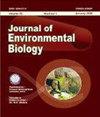Optimization of cold active amylase production by mesophilic Bacillus cereus RGUJS2023 under submerged fermentation
IF 0.7
Q4 ENVIRONMENTAL SCIENCES
引用次数: 0
Abstract
Aim: To produce the highest amount of cold-active alpha-amylase within a short time using mesophilic bacteria with optimized media to save the energy consumption cost and obtain higher enzyme production. Methodology: Amylase producing twenty-three strains were isolated on starch peptone agar plates. Among them, one strain, A5 was selected on the basis of highest clear (12 mm) zone on starch peptone agar plates. It was characterized and identified following Bergey's Manual of Systematic Bacteriology. Enzyme was characterized as Cold alpha amylase. All physico-chemical parameters (temperature, pH, Inoculum size) including carbon, nitrogen, metal ion and amino acid sources were optimized for maximum production of the enzyme. The optimized media was used for enhancing the cold active amylase production. Results: The strain, A5 was identified as Bacillus cereus RGUJS2023 by 16S rRNA sequencing analysis for further experiments. This strain showed the highest activity (9.922± 0.143 U ml-1) on the basal starch peptone media. Though, crude enzyme showed its activity at 4°C to 48°C temperature, but the temperature was 28°C. The highest cold active enzyme was produced (18.87±0.06 U ml-1) at 16 hr of bacterial growth at 35 °C with a pH 6.5 in the optimized media containing 0.5% starch, 0.1% peptone and 0.03% MgSO4.7H2O as a carbon, nitrogen and metal ion sources, respectively, with addition of 0.03% arginine. Interpretation: The cold active alpha amylase could be used commercially for the benefit of pharmaceutical and starch processing industries. Key words: Bacillus cereus RGUJS2023, Cold-active amylase, Starch hydrolysis优化浸没发酵条件下中嗜性蜡样芽孢杆菌 RGUJS2023 生产冷活性淀粉酶的过程
目的:利用嗜中性细菌和优化的培养基,在短时间内生产出最高含量的冷活性α-淀粉酶,以节省能耗成本并获得更高的酶产量。方法:在淀粉胨琼脂平板上分离出 23 株产淀粉酶的菌株。其中,A5 菌株在淀粉蛋白胨琼脂平板上的透明区(12 毫米)最高,因此被选中。根据 Bergey 的《系统细菌学手册》对其进行了特征鉴定。酶被鉴定为冷α淀粉酶。所有物理化学参数(温度、pH 值、接种物大小),包括碳源、氮源、金属离子源和氨基酸源都进行了优化,以最大限度地提高酶的产量。优化后的培养基用于提高冷活性淀粉酶的产量。结果通过 16S rRNA 测序分析,确定菌株 A5 为蜡样芽孢杆菌 RGUJS2023,以便进行进一步实验。该菌株在基础淀粉蛋白胨培养基上的活性最高(9.922± 0.143 U ml-1)。虽然粗酶在 4°C 至 48°C 的温度下都有活性,但在 28°C 的温度下活性最高。在 35℃、pH 值为 6.5 的优化培养基中,细菌生长 16 小时,产生的冷活性酶(18.87±0.06 U ml-1)最高,该培养基分别含有 0.5% 淀粉、0.1% 蛋白胨和 0.03% MgSO4.7H2O 作为碳源、氮源和金属离子源,并添加了 0.03% 精氨酸。解读冷活性α-淀粉酶可用于制药和淀粉加工业。关键字蜡样芽孢杆菌 RGUJS2023 冷活性淀粉酶 淀粉水解
本文章由计算机程序翻译,如有差异,请以英文原文为准。
求助全文
约1分钟内获得全文
求助全文
来源期刊

Journal of environmental biology
ENVIRONMENTAL SCIENCES-
CiteScore
1.70
自引率
0.00%
发文量
92
审稿时长
3 months
期刊介绍:
Information not localized
 求助内容:
求助内容: 应助结果提醒方式:
应助结果提醒方式:


